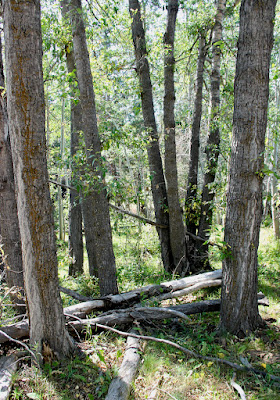
"Trees are our silent partners, sensing us as we move about, providing shelter, offering us beauty, and nurturing and protecting the earth." —the Tree Library
It was another unseasonably warm day—a good time to visit the balsam poplars along Pole Creek in the Laramie Mountains. But it was 80º F even at 8200 ft elevation! So we hiked in and out via the shady trail instead of doing the usual loop. En route I heard crashing in the drainage bottom and spotted a moose ... or rather parts of a moose running off through trees and brush. Sorry, no photos.
Among the poplars it was quite pleasant—shady and cool enough to hang out with the tree I'm following.
 |
| Balsam poplar—Populus balsamifera. |
 |
| (this photo is from last month) |
 |
| Neighboring poplars are smaller, straight, and often clustered. |
 |
| Vigorous stem and root suckers at base of the old poplar. |
Once established, young balsam poplars grow rapidly; this is one of the fastest growing trees in North America at temperate latitudes. But in the absence of disturbance, balsam poplars eventually are shaded out by other trees. This is a problem in protected areas where we prevent disturbances. Stands become senescent.
Dare I speculate about the history of this stand? Currently we see one old balsam poplar with branches sawn off even high up on the trunk (more about this here), surrounded by younger trees that look roughly similar in age. The stand is expanding—young poplars are invading the meadow to the west (photo below), where there is an old well box. The sunny trail immediately north of the stand is the old Happy Jack Road. So ... was this a nice flat area next to the road, with water, where people camped and collected wood for their fires? Or maybe Happy Jack himself lived here. More research needed.
Before returning to the trailhead, we took a short side trip to "Carboniferous Pond" to cool off. There are no cycads, giant horsetails, seed ferns, and such. But dragonflies are so abundant that it feels carboniferous.
This is my September contribution to the gathering of tree-followers kindly hosted by The Squirrelbasket. Sound intriguing? Learn more here.



A majestic tree, and your "best friend" appears thrilled to be accompanying you on your adventures. :)
ReplyDeleteThanks, Beth. Yes, she really enjoys adventures, including tree-following :)
DeleteInteresting post and pictures. Your tree is certainly impressive compared to the others. xx
ReplyDeletethank you, Mike. Have a good weekend :)
Delete